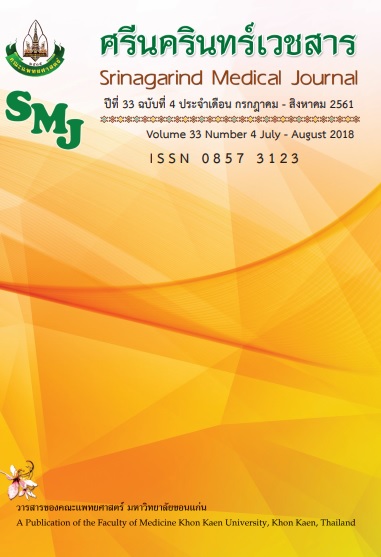The Development of Practice Guideline for Preoxygenation before Anesthesia Induction at Khon Kaen Hospital
Keywords:
Practice Guideline, Preoxygenation before anesthesia induction, แนวปฏิบัติ, การให้ออกซิเจนก่อนนำสลบAbstract
การพัฒนาแนวปฏิบัติในการให้ออกซิเจนก่อนนำสลบ โรงพยาบาลขอนแก่น
วิรัตติยา ป้อมสุวรรณ1*, อักษร พูลนิติพร2, รัชยากร ลิ่มอภิชาต2 , จารี แสงสว่าง1
1 วิสัญญีพยาบาล กลุ่มงานการพยาบาลวิสัญญี โรงพยาบาลขอนแก่น
2 วิสัญญีแพทย์ กลุ่มงานวิสัญญีวิทยา โรงพยาบาลขอนแก่น
หลักการและวัตถุประสงค์: การให้ออกซิเจนก่อนการนำสลบเป็นกระบวนการสำคัญเพื่อป้องกันภาวะพร่องออกซิเจนระหว่างการนำสลบในการดมยาสลบแบบทั่วตัว โรงพยาบาลขอนแก่นมีอุบัติการณ์พร่องออกซิเจน 1-2 ราย/เดือนและร้อยละ 30 เกิดในช่วงนำสลบ บุคลากรวิสัญญีมีวิธีการให้ออกซิเจนก่อนนำสลบแตกต่างกัน การศึกษานี้มีวัตถุประสงค์เพื่อพัฒนาแนวปฏิบัติในการให้ออกซิเจนก่อนนำสลบ และวัดผลลัพธ์การใช้แนวปฏิบัติและประเมินความพึงพอใจของผู้ใช้แนวปฏิบัติ
วิธีการศึกษา: เป็นการศึกษาเชิงปฏิบัติการ (action research) ใช้ขั้นตอนพัฒนาแนวปฏิบัติของศูนย์ปฏิบัติการพยาบาลขั้นสูงมี4 ขั้นตอน ได้แก่ การวิเคราะห์ปัญหา สืบค้นหลักฐานเชิงประจักษ์เพื่อพัฒนาแนวปฏิบัติ ตรวจสอบโดยผู้เชี่ยวชาญ นำแนวปฏิบัติไปทดลองใช้กับผู้ป่วย และปรับปรุงให้เหมาะสม นำไปใช้กับผู้ป่วยอีกครั้ง ประเมินผลลัพธ์และความพึงพอใจ
ผลการศึกษา: มีผู้ปฏิบัติ 40 ราย แนวปฏิบัติมี 7 ขั้นตอน นำมาใช้กับผู้ป่วย103ราย ร้อยละ 69.9 เป็นเพศหญิง และร้อยละ 49.5 เป็นผู้ป่วยASA physical status 1 ผลการใช้พบว่า เวลาเฉลี่ยที่ทำให้ETO2เป็นร้อยละ80 คือ 61.36 วินาที สามารถหยุดหายใจนานมากกว่า 4.8 นาทีโดยไม่เกิดภาวะพร่องออกซิเจน ผู้ปฏิบัติร้อยละ82.5 มีความพึงพอใจมากที่สุด และร้อยละ 17.5 พึงพอใจมาก
สรุป: แนวปฏิบัติในการให้ออกซิเจนก่อนนำสลบ โรงพยาบาลขอนแก่น สามารถใช้ได้อย่างมีประสิทธิภาพ และปลอดภัย
procedure to prevent desaturation during induction of general anesthesia. Incidence of desaturation in Khon Kaen hospital was 1-2cases per month and 30% of these were occured during induction. Various techniques were used by anesthesia personnel for preoxygenation.This study aimed to develop practice guideline for preoxygenation before anesthesia induction , evaluated outcomes and participants’s satisfication.
Methods : This study was action research. The center for advanced nursing practice evidence-based practice model was used. Four key elements were planning (problem identification), literature reviewed and developed the practice guideline then evaluated by the expert , observed results after guideline using and reflection. The outcomes and participants’s satisfication were collected.
Results : Forty participants were enrolled. The 7 steps-practice guideline were used in 103 patients, 69.9% were female, 49.5% were ASA physical status I. Average time to get end tidal oxygen equal to 80% were 61.36 seconds. Desaturation after intubation were not found and even maximum time used to intubate were 4.8 minutes. Most of participants satisfied the practice guideline as excellent (82.5%) and good (17.5%).
Conclusion : The practice guideline for preoxygenation before anesthesia induction developed in Khon Kaen hospital provided effective oxygenation and safe procedure.
References
Benumof JL. Preoxygenation Best Method for Both Efficacy and Efficiency(Editorial). Anesthesiology1999; 91: 603-5.
Tanoubi IS. Oxygenation before anesthesia (preoxygenation) in adults. Anesthesiol Rounds 2006;5(3)(Cite by 7).
American Society of Anesthesiologists Task Force on Management of the Difficult Airway. Practice guidelines for management of the difficult airway. An updated report. Anesthesiology 2003; 98: 1269-77.
Punjasawadwong Y, Chinachoti T, Charuluxananan S, Pulnitiporn A, Klanarong S, Chau-in W, Rodanant O. The Thai Anesthesia Incidents Study (THAI Study) of oxygen desaturation. J Med Assoc Thai 2005; 88(Suppl 7): S41-53.
Suksompong S, Chatmongkolchat S, Hintong T, Klanarong S, Cha-in W, Virankabutra T. The Thai Anesthesia Incident Monitoring Study (Thai AIMS) of desaturation: an analysis of 1,996 incident reports. J Med Assoc Thai 2008; 91: 1389-96.
Gambee AM, Hertzka RE, Fisher DM. Preoxygenation techniques: comparison of three minutes and four breaths. Anesth Analg 1987; 66: 468-70.
Baraka AS, Taha SK, Aouad MT, El-Khatib MF, Kawkabani NI. Preoxygenation comparison of maximal breathing and tidal volume breathing techniques. Anesthesiology: Anesthesiology1999; 91: 612-6.
Nimmagadda U, Salem MR, Joseph NJ, Lopez G, Megally M, Lang DJ, Wafai Y. Efficacy of Preoxygenation with Tidal Volume Breathing Comparison of Breathing Systems. Anesthesiology 2000; 93: 693-8.
Baraka AS, Salem MR. Preoxygenation. In: Hagberg CA, Gabel JC, editors. Benumof and Hagbers’s airway management. 3th Ed. Philadelphia: Elsevier saunders; 2013: 280-97.
Nimmagadda U, Chiravuri SD, Salem MR, Joseph NJ, Wafai Y, Crystal GJ, El-Orbany MI. Preoxygenation with tidal volume and deep breathing techniques: the impact of duration of breathing and fresh gas flow. AnesthAnalg 2001; 92: 1337-41.
เข็มเพชร เศรษฐ์สัมพันธ์ , เวณิกา แพงวงษ์, อักษร พูลนิติพร. Preoxygenation with Oxygen-prefilled Anesthesia Breathing System Increased End Tidal Oxygen within Two minute :A Randomized Controlled Trial. Thai J Anesthesiology 2018; 44: 51-7.
Baraka A. " Routine" preoxygenation before induction of and recovery from anesthesia (a safety precaution)(Editorial). Middle East J Anesthesiol 2010; 20: 769-71.
Nimmagadda U, Salem MR, Crystal GJ. Preoxygenation: physiologic basis, benefits, and potential risks. Anesth Analg 2017; 124: 507-17.
Soukup SM. The Center for Advanced Nursing Practice evidence-based practice model: promoting the scholarship of practice. Nurs Clin North Am 2000; 35: 301-9.
Tanoubi I, Drolet P, Donati F. Optimizing preoxygenation in adults. Can J Anesth 2009 ;56:449-66.
Nimmagadda U, Salem MR, Joseph NJ, Miko I. Efficacy of preoxygenation using tidal volume and deep breathing techniques with and without prior maximal exhalation. Can J Anesth 2007; 54: 448-52.
Pandit JJ, Duncan T, Robbins PA. Total Oxygen Uptake with Two Maximal Breathing Techniques and the Tidal Volume Breathing Technique A Physiologic Study of Preoxygenation. Anesthesiology 2003; 99: 841-6.
Lane S, Saunders D, Schofield A, Padmanabhan R, Hildreth A, Laws D. A prospective, randomised controlled trial comparing the efficacy of preoxygenation in the 20° head up vs supine position. Anaesthesia 2005; 60: 1064-7.
Melnyk BM, Fineout-Overholt E, editors. Evidence-based practice in nursing & healthcare: A guide to best practice. Lippincott Williams & Wilkins; 2011.
อรุณ จิรวัฒน์กุล. ชีวสถิติสำหรับงานวิจัยทางวิทยาศาสตร์สุขภาพ.ขอนแก่น : โรงพิมพ์คลังนานาวิทยา; 2551.
BARAsH PA, Cullen BF, Stoelting RK, Cahalan M, Stock MC, Ortega R. Handbook of clinical anesthesia,7thEd. Lippincott Williams & Wilkins; 2013:774.


